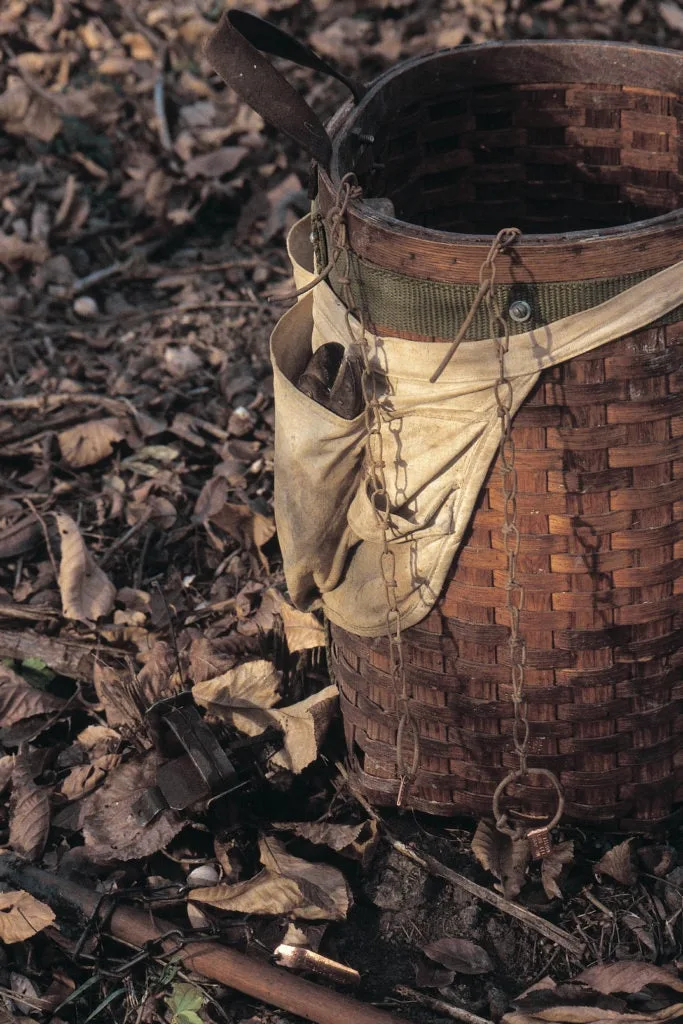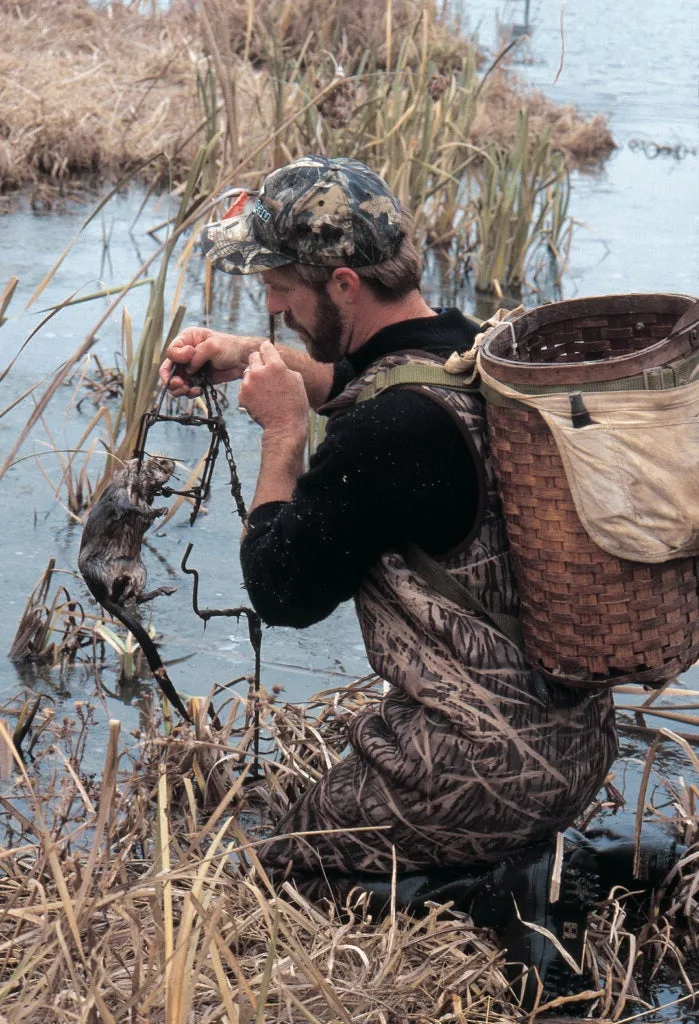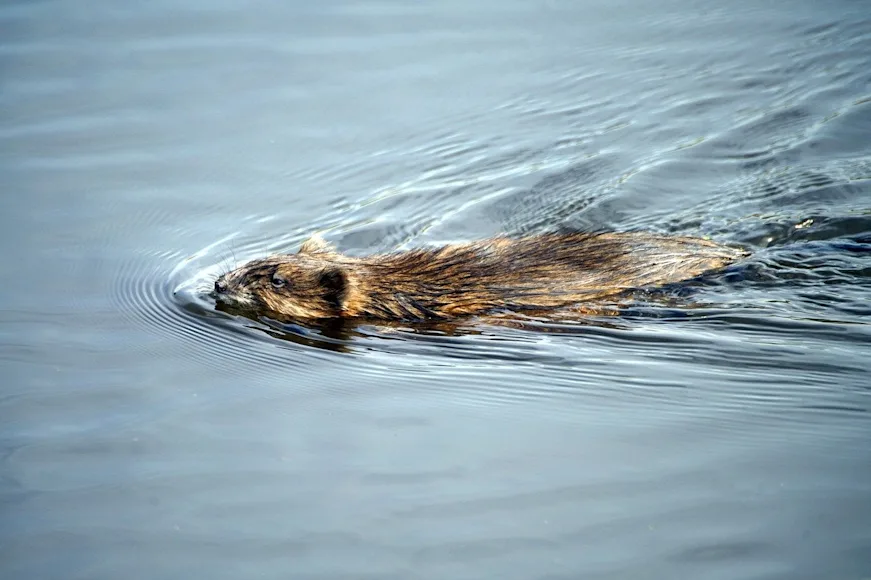Growing up, in northeast Ohio in the early 1970s, trapping was a huge part of what my father and I did every Fall. And while we didn’t specifically target muskrats, they were our bread and butter. Why? For the same reasons a lot of people trapped muskrats back in the day: They were abundant to the point of overpopulation in many places, they weren’t too hard to catch, they were (and still are) incredibly quick and easy to put up (skin/stretch), and, at least in 1979, brought $6 to $8 per pelt.
Today, trapping is, sadly, damn near a thing of the past. When I sold my last batch of muskrats in Iowa around 2009, I averaged 35 cents a pelt. But trappers still trap, and they still trap plenty of muskrats in swamps, sloughs, ponds, and creeks across the nation. So let’s say you want to get started trapping muskrats. What do you need? Where do you look? How do you make a set? And, what the hell do you do with a muskrat after you’ve caught it? You’ve come to the right place. Welcome, to muskrat trapping 101.
The Best Muskrat-Trapping Gear For Beginners

A sturdy pack basket is great for holding all of your gear, but you can also use a 5-gallon bucket. M.D. Johnson
True, trapping furbearers, even muskrats, can be equipment intensive. But one of the best things about ‘rat trapping is that it doesn’t have to be. A handful of traps, some odds and ends of gear, a carry-all, and a set of chest waders or hip boots, and you’re essentially in service. Here’s a list of gear for the beginning muskrat trapper:
Pack basket
For trapping, I prefer a woven wood basket
with adjustable pack straps and a good, solid wood bottom. My personal pack basket is maple veneer, and while she shows a little wear at age 40, she’s still in fine working condition. Some trappers prefer to use tall 5-gallon buckets with drain holes drilled in the bottom for hauling. I can’t argue with that, but I want something I can strap on my back.
4 Kinds of Muskrat Traps
This one’s open to debate, as some trappers use specific styles and sizes of traps. But, if you’re just getting started, I would suggest six #1 long-spring legholds, six #1 stop-loss style legholds, and 12 #110 Conibear body-gripping traps. Traps usually need to be tagged with your information before setting them. Check your local regulations on trapping.
1) #1 Long-Spring Legholds
A traditional leghold-style trap
well suited for muskrats, the long spring leghold is simple to set and place. However, owing to a muskrat’s tendency to twist out of a leghold trap, these should be used in deep-water drowning applications.
2) #1 Stop-Loss Style
Almost identical to the #1 Long Spring, the stop-loss
incorporates a spring-loaded transfer bar, that holds a muskrat away from the trap itself, preventing loss from twisting.
3) #110 Conibear
In my opinion, the #110 Conibear
is the muskrat trapper’s best friend. A single spring powers two box-shaped jaws or arms. When the ‘rat passes through, it releases a trigger, and the jaws snap closed fore and aft, killing the animal immediately.
4) #1 Jump-Style Traps (Optional)
I love small jump traps for their versatility and effectiveness. A single shortened spring provides tension to two jaws. When triggered, the trap “jumps” vertically gaining a high hold on the target. Jump traps are lightweight, easy to use, and they sit, or “bed,” very flat.
Stakes
Stakes secure and hold traps in place. Muskrats typically don’t need much in the stake department. A 1″ x 1” wooden tomato stake 4 to 5 feet long is often plenty. One thing to keep in mind though is that both mink and raccoons have a way of blundering into muskrat sets. Keep this in mind when securing traps, and err on the side of strength.
Wire and Accessories
Any ‘rat trapper worth his or her salt will have a roll of #16 black stovepipe wire, a good set of side wire cutters, 10-inch black zip ties, and a 6- to 8-inch sheath knife, all for wiring and securing traps, cutting stakes or bait, and 1,001 other things. I’ll often carry a light hatchet, too.
Lures and baits
Sweet-smelling liquid lures or scents designed to attract muskrats to the trap site are available online and may work to some extent. However, I’ve had good luck using apple quarters, which provide both a visual and olfactory element to the set. If you find a hot spot, like an active feed bed (vegetative feeding platform), lures and baits become unnecessary.
Flagging
Orange flagging tied onto trap stakes serves to answer the question of, “Where the hell did I put that one?” I’d recommend this only on private waters or where trap loss due to theft isn’t an issue.
Where to Trap Muskrats
I’ve found and successfully trapped muskrats in ponds, lakes, streams, rivers, swamps, marshes, and drainage ditches. With water, food, and soft dirt banks for tunneling, muskrats will—and do—make themselves at home from coast to coast.
For the novice, the easiest place to trap is a small pond or shallow marsh. In a pond, muskrat runs, the paths the animals use as they travel in and out of their dwelling, are often quite visible, thanks to the mud that’s stirred up as the animals travel back and forth. Muskrats dwell in holes in the bank and in domed structures made of nearby native materials, like cattails, called muskrat houses or huts. On still water, runs, bank dens, and huts should be easy to find.
Moving water, like creeks, streams, or rivers, can provide excellent muskrat trapping opportunities but presents a couple of challenges. One, the current flushes away the mud that would otherwise reveal muskrats runs. And two, with a little rain and rising water, the traps you set under an inch can be covered with a foot of muddy torrent when you return, or lost completely.
4 Basic Muskrat Sets For Beginners
Every ‘rat trapping scenario is going to be a little bit different due to the surroundings. However, there are a handful of sets that every trapper should know.
1) The Bank Den- or Hut-Entrance Set
Locate a bank den entrance under the water with your hand or the toe of your boot. Then slip a tomato stake through the circular spring on a #110 Conibear to a height dependent on water/mud depth. Drive the stake into the mud and secure the trap to it tightly with a cable tie. Compress the spring, set the trigger, position the trap 6 to 8 inches just outside of a bank den entrance hole.
2) The Feed-Bed Set
Set a stop-loss or jump trap an inch below the water at the spot where a muskrat accesses a feeding platform, which is evidenced by a narrow flattened trail and bits of discarded cattail (often white) or other vegetation. Bed the trap firmly; that is, set it level and solid, so it doesn’t rock or shift as the ‘rat climbs aboard the feed bed. Lengthen the trap chain with wire by 12 to 36 inches, depending on water depth, and stake securely.

Conibear traps kill instantly and can be set under water. M.D. Johnson
3) Run or Travel-Route Sets
These prime locations will appear as trails through the cattails, coontail, algae, or duckweed, with or without mud. Set a #110 Conibear and tomato stake somewhere along the run just as you would at a bank den. Position the dog of the trap (the notched arm that fits into the top of the two-wire trigger) 2 inches above the waterline. Finish the set by bending a light handful of cattails overtop the trap. The key is to break up the square outline of the Conibear.
4) The Toilet Set
Muskrats often use near-horizontal logs rising out of the water as regular toilets. You can find them by looking for an accumulation of brownish bean-shaped droppings atop the log. This set calls for a #1 jump trap fastened, spring tab up, to the log with light twine, just below the waterline. The trick here is to secure the trap so it’s stable, but not so tight that a muskrat can’t break the trap free of the log and reach deeper drowning water. Occasionally, I’ll notch the log to allow the trap to sit flat.
**Read Next: Why Learning How to Trap Can Improve Your Turkey Hunting
**
How to Skin a Muskrat
If you can take a glove off inside out, you can skin a muskrat. Here’s my method, step-by-step:
Hang the muskat from the rafters—I’m assuming you’re doing this in an outbuilding and not in the kitchen, although I’ve been known to do just that—at a comfortable working height, by each back leg with binder twine or other strong cord.
Using a short-bladed sharp knife, cut around each hind leg at the ‘wrist’ joint, the scaly tail, and each front foot.
Make a cut from each hind leg to the tail..
Begin peeling the hide down and away from the carcass with your fingers starting at each hind leg and working toward the head. Be careful of the belly skin, as it’s terribly thin and prone to tearing. Pull the pelt over each front foot and continue to the head.
Use a small knife to work at the ears, eyes, and nose and free the inverted pelt from the carcass. Pelts can be rolled, fur out, nose to tail, placed in plastic bags and frozen for market. Some trappers recommend freezing muskrat pelts fur side out and flat. I’ve found that either method works. I always _s_crape or remove the fat and flesh and stretch my muskrat hides before taking them to my fur buyer. But this often depends on what the individual buyer wants.






